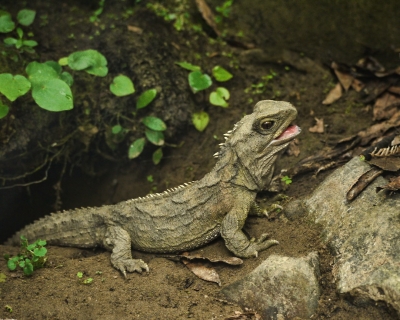
The tuatara reptile is known as a ‘living fossil’ or ‘living dinosaur. Found in New Zealand only, the single species of tuatara (Sphenodon punctatus) is the sole-surviving member of its order Rhynchocephalia, which originated in the Triassic period around 250 million years ago. The word tuatara is a Maori word meaning “peaks on back”. The tuatara’s “third eye” on the top of its head has a retina, lens and nerve endings, yet it is not used for seeing. It is visible in young tuataras but becomes covered with scales in adult years. Tuataras can live up to a hundred years in the wild.
The tuatara family contains only two nearly-identical species, Sphenodon punctatus and the even rarer S. guntheri, which are confined to Brothers Island off New Zealand. As these are the only surviving species of the order Sphenodontia, it is difficult to track the animal’s evolutionary history. Researchers often combine knowledge from the fossil record with genetic information from living relatives to determine how rapidly DNA is mutating.
For instance, if two species are known to have split apart from a common ancestor at least 50 million years ago, researchers can sequence the same fragment of DNA from living animals in several branches of the family tree, compare the sequences, and calculate the rate at which the DNA has changed since the common ancestor. “People often use living relatives to calibrate rates of molecular evolution,” says Lambert. “If you don’t have those living relatives, that’s going to be hard.”
Picture Credit : Google




